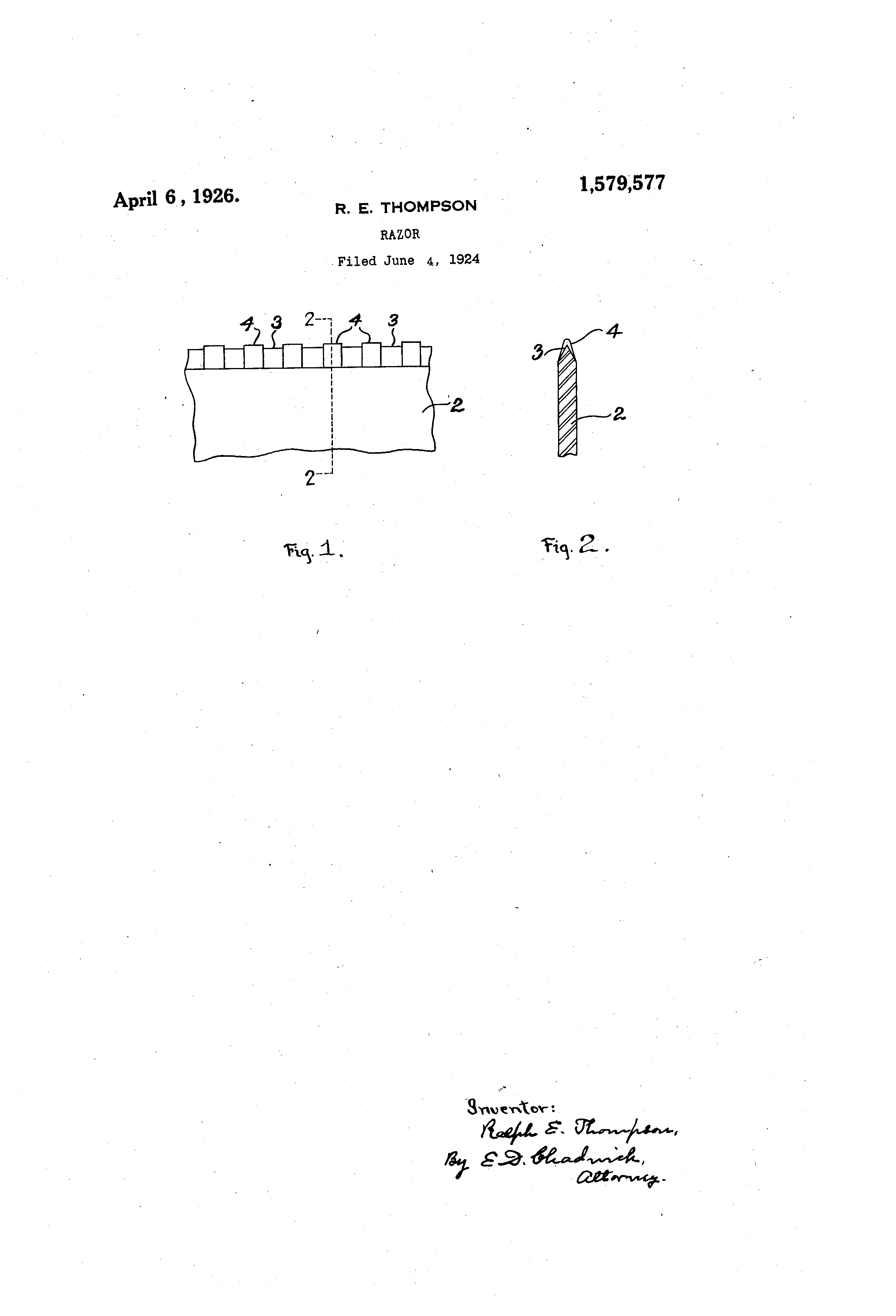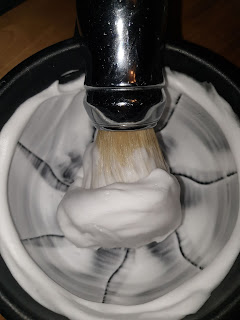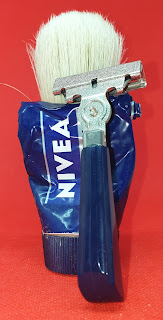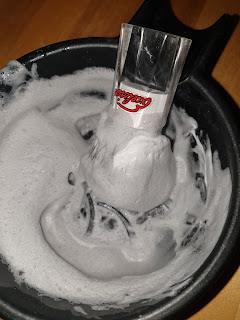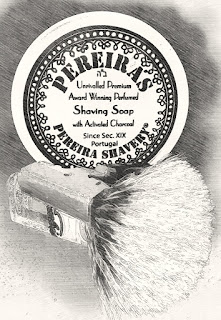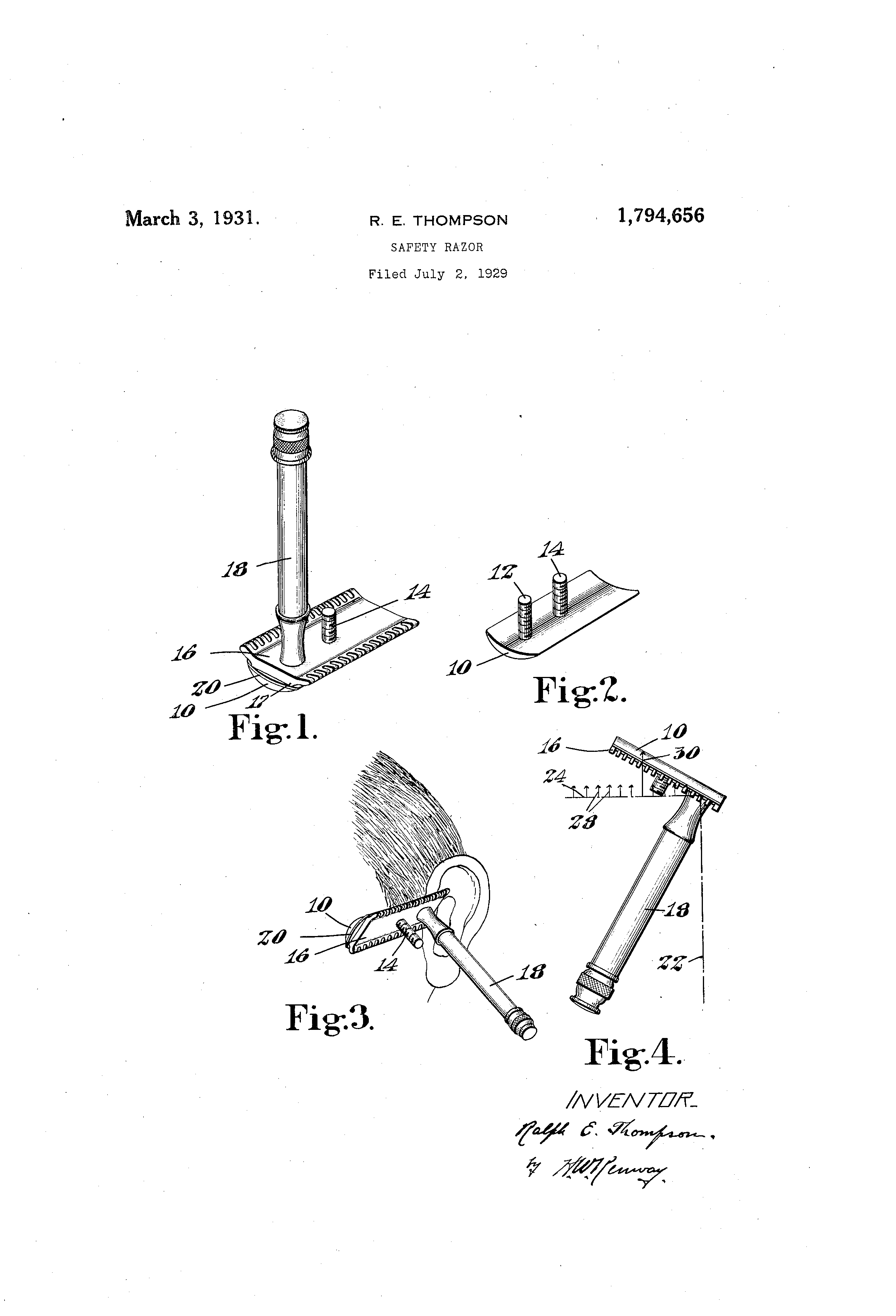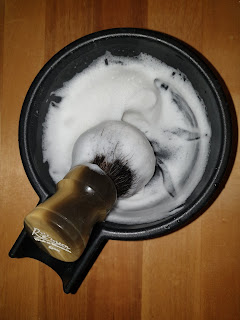Razor: Shick G4
Blade: Proraso Injector
Brush: Vie-Long #14033
Lather: GzD Shavestick
Aftershave: Body Shop Macau Root Energetic Face Protection
Additional Care: Alum Block, BullDog Original Beard Oil, & Pereira Shavery Boomerang Beard Comb
Shaving legs
A somewhat sexists vintage cartoon, but I can testify that if you offers the lady in your life to whip up some proper lather the next time they are about to shave their legs they will thank you later. A smoother shave, less ingrown hairs, softer skin… why should your face be alone in enjoying those benefits?
Sharing is caring, and sharing a shave is caring even more.
Shave of the day 16th October
Ralph E Thompson’s 1924 safety blade patent
I’ve mentioned Ralph E Thompson and his stack of razor patents (the majority of which is assigned to Gillette Co) before, and one of his earliest ones are for a peculiar blade design – suitable, he claims, for both safety razors and razors of the open-blade type.
The basic idea what that the blade should, in effect, be it’s own guard. In his own words:
…a razor blade having a safety edge, by which I mean an edge which is self-protected in such manner as to prevent it from cutting the skin without materially impairing its effectiveness for shaving.
And how was this to be achieved? Well, the drawing make it reasonable clear that the secret was how the blade was ground.
By having alternating sharp and blunt portion of the blade, the edge would act as a safety comb. Or, as Mr Thompson puts it:
A blade embodying my invention is characterized by having its shaving edge provided with a series of alternating sharp an dull portions of limited extent, of which the dull portions are located near enough together to prevent the sharp portions from entering the skin of the user when the blade edge is which ting them to reach the beard in the act of shaving. I have found that in spite of the presence of the dull portions a clean and comfortable shave can be readily obtained…
In addition to being safer for shaving, such a blade should be – according to Mr Thompson – be safer to handle outside of the razor as well.
While I can see several reasons why this blade never took of, there are two that stands out to me. Firstly, the machinery that ground and honed razor blades would have to be significantly redesigned, which would mean a significant investment. Secondly, say goodbye to a decent one-pass shave – this blade would by design miss roughly half the stubble.
Shave of the day 14th October
Shave of the day 11th October
Meyer Eugen’s skin-stretching razor
Razors shave better over stretched skin, which is why most of us do a bit of facial contortions as we have our moment of daily Zen.
Meyer Eugen, of Wurttemherg in Germany, had other ideas on how to achive the desired tightening of the skin… as he states in the patent he filed in 1961:
When shaving with a safety razor, the skin is usually tightened so as to raise up the hairs relative to the blade to permit them to be cut as closely as possible toward their roots, whereupon the remaining stubs will recede into the released skin. In order to attain this result, numerous designs of safety razors have already been proposed. Thus, for example, the comblike guard in front of the razor edge of earlier safety razors was replaced by a beaded friction bar which, however, was too smooth and exerted too little friction upon the skin.
I never figured the point of the safety bars or comb was to provide friction… I’ve always believed the point was to stop the blade digging into your cheek and taking off the outer layer of skin – along with the deeper layers, flesh and a surpricing amount of blood. I’m not saying Herr Eugen was wrong in his assertion, just that his view isn’t shared with most shavers. He does then go on to describe other failed – in his opinion – ways to provide friction, before revealing his brilliant idea:
It is an object of the present invention to provide a safety razor in which the friction bar produces a considerably improved skin-tightening and hair-raising effect so that the hairs will be cut more closely to the skin. This is attained according to the invention by providing the bottom plate of the razor with a friction bar of a curved shape as seen in cross section, which is divided into a plurality of serrations or teeth of an angle, the bisector of which is inclined away from the razor edge and toward the base of the friction bar so that the serrations have a shape similar to the teeth of a file or saw. The serrations may form a plurality of straight rows of teeth or series of individual teeth, scales, or the like which may be offset relative to each other. The longitudinal rows of teeth always extend transverse to the axis of the razor handle and therefore also transverse to the shaving direction of the razor. Thus, if the head of the razor extends at right angles to the axis of the handle, the serrations extend parallel to the edge of the razor blade and if it extends obliquely to the axis of the handle the serrations extend obliquely to the razor edge. In the latter case, the friction bars may be provided with additional serrations or grooves which extend in the shaving direction and exert a guiding effect.
In other words he wanted to turn the safety bar into a rasp or a file, which would hold onto and tug on the skin and stubble, holding onto hair and raising them up; there is a quite wordy technical description of how the undercut teeth on the safety would not only force the hairs upright, but also allow for easy detection of missed hairs.
The rest of his razor seems to be a fairly standard three piece razor, although the drawings also show a variation where the head is mounted at a 45° to the handle.
Given that modern razors don’t seem to be manufactured with the idea that the safety bar or comb should provide as much friction as possible in order to pull the skin tight when we’re shaving, I’ll leave it up the reader to assess how successful Herr Eugen’s patent were in the grand scheme of things.
Shave of the day 9th October
Razor: Shick G4
Blade: Proraso Injector
Brush: Semogue TSN LE 2012
Pre-Shave: The Lavish Gentleman Natural Strength Oil Cleanser
Lather: Pereira Shavery Orange Blossom w/ activated charcoal
Aftershave: Myrsol Aqua De Limón
Additional Care: Alum Block, Gentlemen of Sweden Original Beard Oil, & Pereira Shavery Boomerang Beard Comb
Ralph E Thompson’s 1929 offset razor patent
Ralph E Thompson have quite a few razor related patents to his name, most of them assigned to Gillette Company… and one of them caught my eye. As the patent text says:
I have discovered that the capacity of such a safety razor is increased, that it is adapted or certain special uses and that its shaving efficiency is improved by providing, a series It of spaced connecting devices formed in the holderwhich may be employed selectively in attaching the handle thereto.
Or in simpler words; a razor where you can move the handle back and forth. Ralph depicted a razor with two studs in his patent drawing; one in the centre where one would expect to find one, and one towards the end of the razor head.
While I personally have no issues shaving near my ear as shown in the drawing, it is likely that the main idea was not to get a neater shave around your side burns but to more easily facilitate the “Gillette Slide” – a technique where you held the razor at about a 45° angle as you pulled it across your whiskers.
I can see a couple of issues with the design of Mr Thompson’s razor. One of the big ones is that if you move the handle to one end of the razor head, the clamping force at the far end of the blade is reduced, leading to potential blade chatter and uneven shaves.
Shave of the day 7th October
Razor: Shick G4
Blade: Proraso Injector
Brush: Artesania Romera Manchurian Badger, imitation horn
Pre-Shave: The Lavish Gentleman Natural Strength Oil Cleanser
Lather: Mike’s Natural Soaps Pine & Cedarwood
Aftershave: Nivea Cooling After Shave Balm
Additional Care: Alum Block, BullDog Original Beard Oil, & Pereira Shavery Boomerang Beard Comb



